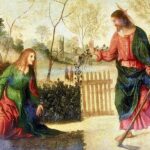 Even a cursory glance through the Book of Revelation shows you that it is chock-full of angels. There isn’t a chapter that doesn’t mention them in one form or another, and much of the action in the book comes about through the speech or action of the angels. But have you ever counted them, or noted what they do and when and why?
Even a cursory glance through the Book of Revelation shows you that it is chock-full of angels. There isn’t a chapter that doesn’t mention them in one form or another, and much of the action in the book comes about through the speech or action of the angels. But have you ever counted them, or noted what they do and when and why?
I recently went through the text, and this is what I found:
| Verse | Angelic character | Recurs? |
| 1.1 | Revealing angel | 22.16 |
| 1.20 | Angels of seven assemblies | Chapters 2 and 3 |
| 3.5 | The angels of my Father | The ones in 5.11? |
| 5.2 | A mighty angel | No |
| 5.11 | Myriads of angels | 7.11 |
| 7.1 | Four angels at the corners of the earth | No |
| 7.2 | Another angel with seal | No |
| 7.11 | The angels around the throne | |
| 8.2 | The seven angels [presumably of Jewish tradition] | Chapters 8 and 9 and 11.14; Michael named in 12.7 |
| 8.3 | Another angel (with the golden censer) | Poss in 14.18? |
| 9.11 | The angel of the abyss | No |
| 9.14 | The four angels at the Euphrates | No |
| 10.1 | Another mighty angel | Chapter 10 |
| 12.7 | Michael (and his angels) | No |
| 12.9 | The devil’s angels | No |
| 14.6 | Another angel (flying) | No |
| 14.8 | Another angel | No |
| 14.9 | Another angel | No |
| 14.15 | Another angel | No |
| 14.17 | Another angel (with sickle) | No |
| 14.18 | Another angel (from 8.3?) | No |
| 15.1 | Seven angels with the seven last plagues | Chapter 16 |
| 16.5 | The angel of the waters | No |
| 17.1 | One of the angels with the seven plague bowls | Chapter 17 (but not 21.9) |
| 18.1 | Another angel with splendour | No |
| 18.21 | A mighty angel | No |
| 19.17 | An angel standing in the sun | No |
| 20.1 | An angel with the key to the abyss | No |
| 21.9 | One of the angels with the seven plague bowls | Prob chapters 21 and 22 |
| 21.12 | Twelve angels on the gates of the city | No |
| 22.16 | Revealing angel | n/a |
(If you do go through the book, and find I have made any errors here, do let me know as I am presenting a paper on this soon!)
There are things to be said about each of these in turn—but also things to be said about the list as a whole. There is some debate about the seven angels of seven assemblies in each of the cities to which John is writing. They are unlikely to be human messengers, despite their role in receiving the messages that follow, since angels are so prominent in Revelation and are consistently heavenly. Neither should they be taken as standing for the ‘spirit’ of the churches in terms of their character. The most likely background is that of Daniel, where angels represent the earthly reality of nations and peoples in the heavenly realms (Dan 10.12, 12.1) so Jesus holding the star/angel signifies his hold on the church communities themselves.
The myriads of angels in worship in 5.11 are very striking—not least because John is writing to a very small early Christian community, who would have seen themselves as having very little influence in the world in which they lived. This can lead either to fear (what can I do in the face of opposition?) or compromise (what point is there in resisting?) and we can see evidence of both in the text. But John has the audacity—the gall—to suggest that this tiny group are on the right side of history, and it is the might of the Roman Imperial system, which shapes, commands and controls so much of their world, that will ultimately come to grief. And the myriads of angels contribute to this, much as Elisha revealed the armies of heaven to his servant in 2 Kings 6.17. It is, we might say, John’s say of telling his audience that ‘One plus God is a majority’.
But the most striking thing about the angels as a group of characters is the fact that they just appear and disappear, often with no explanation, and with little continuity. Notice how many in my list simply never recur again. The discontinuity and lack of explanation is evident from the start, since the ‘revealing angel’ mentioned in 1.1 and 22.16 simply never appears or is referenced within the text, and it is a striking aspect of John’s revelatory experience that it is unmediated by an angeles interpres in contrast to some important contemporary Jewish apocalypses. From a narrative perspective, many of these angelic figures are minor characters, who are ‘flat’ rather than ‘rounded’, and with what we might call ‘walk on’ parts function as devices to move the plot on, either by making a statement or being agents for the next stage of the action. This is particularly the case when the introduction of ‘another angel’ (a phrase occurring ten times) is accompanied by the phrase ‘And I saw’ which functions to introduce a new actor or scene within a vision section or the start of a new vision section.
The subordination of the angelic characters to greater theological concerns or movements of the plot is evident in several ways. Even the angels which appear to have a significant role (the mighty angel described in detail in 10.1, the splendid angel in 18.1, the one standing in the sun in 19.17 and the angel with the key to the abyss in 20.1) simply disappear from view as John’s vision report moves on. Frequently, they function vicariously to signify the attributes and actions of God—so ‘mighty’ angels indicate divine power, and those commanding forces on the earth indicate God’s sovereignty. The only ones introduced with the definite article come in 8.2 as ‘the seven angels who stand before God’. John’s audience would likely have thought of the seven great angels of Jewish thought (named as Michael, Gabriel, Raphael, Uriel, Raguel, Phanuel and Sariel in 1 Enoch) but it is striking that they are not named in this passage—the focus is not on the angels but on their action. (The later naming of Michael in 12.7 functions as an allusion to Daniel, rather than in relation to Michael as one of the group here.)
This ‘sidelining’ and discontinuity of the angelic actors has a particular affect on the the feel of the text for readers, and it supports other aspect of the sense of discontinuity in the text. Perhaps the most important of these is the frequent changes of genre, or style of writing, which is particularly noticeable in the first chapter:
| Verse | Text | Genre |
| 1 | The revelation of Jesus Christ… | Apocalyptic |
| 3 | Blessed is the one who reads aloud the words of this prophecy… | Benediction |
| 4 | John, to the seven churches in the province of Asia… | Epistle |
| 5–6 | To him who loves us and has freed us from our sins … be glory and power for ever and ever! Amen | Doxology |
| 7 | Look, he is coming with the clouds…! | Apocalyptic |
| 8 | “I am the Alpha and the Omega,” says the Lord God | Prophecy |
| 9 | I, John, your brother and companion… | Epistle |
Though these verses contain the most dense series of changes in microgenre, such abrupt changes are also found throughout the text, most notably in the transition to hymnic material, in chapter 12 with its distinct changes in verses 7, 10 and 13, in the interjections in chapter 18, and in the changes in style and speaker (mostly unannounced) in chapter 22.
Stability and consistency of genre makes texts (in the French literary critic Roland Barthes’ terms) ‘writerly’, that is, they are texts whose meanings are controlled by the writer which tend to eliminate interpretive ambiguity. But texts like this, where genre is changing, unstable and even in some cases indeterminate, are ‘readerly’ texts—they provoke and invite active involvement in construing meaning by the audience. This idea fits with other features of Revelation as a text of participation; at certain points the lector (1.3) might anticipate the audience actually joining in (for example, in the ‘Amen!’s of 1.6, 7, 5.14 and 22.20), and there are even points where John as author appears to spontaneously interject, unannounced, his own asides into his vision report (eg 18.14) as does the exalted Jesus (22.12–13). And the structured repetition of the hymnic stanzas of praise make for very easy participation for anyone hearing the text more than once.
John also makes reference to angels as a way of structure his vision report. The structure of chapter 14 is a point of debate amongst commentators, and in particular the relation between the two harvests, the grain harvest and the grape harvest, and whether the second really belongs to the following chapter. The introduction of six unnamed angels (all labelled ‘another angel’) actually comes as two sets of three, something brought out by English translations which often number them though the Greek text does not. They serve to tie the two sections together and give them a structural unity. Something similar happens in the mention of ‘one of the seven angels who had the seven bowls’ in 17.1 and 21.9. There is no indication from the wording that this is either the same one of the seven or a different one; John appears to be uninterested in this. Instead, the repetition of the phrase reinforces the contrast between the vision of the great prostitute in chapter 17 and the bride of the lamb in chapter 21, a contrast that is developed by the different descriptions of splendour of the two woman-cities.
So angelic character discontinuity functions to disrupt audience expectations and keep the focus on the main characters, particular God and the lamb, and God’s attributes and actions. The introduction of so many unnamed characters is often a plot device to move us on to the next scene, and their discontinuity functions with other unsettling aspects of the text to invite is into involvement and engagement with the text. And the sheer number involved suggests that there is no shortage of angelic assistants that John (and his audience) might draw on. If we really are ‘on the side of the angels’ then, despite our fragility and minority status in our culture, we are in the majority.
Follow me on Twitter @psephizo. Like my page on Facebook.
Much of my work is done on a freelance basis. If you have valued this post, would you consider donating £1.20 a month to support the production of this blog?




























Isn’t it time to stop talking about angels as if they really exist? Such talk just confirms the general view of those outside the church that it’s necessary to believe six impossible things before breakfast in order to be a Christian. If you regard angels as just a literary device, to be understood metaphorically then you should say so. No doubt among theologians who read your blog most will just assume this is your intention, but general readers need a clearer statement.
I don’t actually think that is true. The biblical narratives depict them as real—and there are a surprising number of people well outside the church who believe in angels.
What a lovely article! I believe in God and that He sends His holy angels on assignment.
There are angels for specific purposes- I think about the angels in the Lord Jesus Christ’s tomb after His resurrection, and the ones after His ascension to heaven a lot. The way they faithfully deliver God’s messages!
They are gentle creatures of God – even when they do seemingly harsh things – such as the one that met Balaam and donkey, and the one in the temple with Zechariah) they do it with utmost grace!
They also don’t accept worship, and they are sent to us from God, we don’t summon them! If you summon an angel and he accepts your worship or is threatening in any way- that angel is likely to be a fallen angel- from the abyss, or the pits of hell, satanic and on Lucifer’s side- run!
I don’t believe the Book of Revelation comes from our Heavenly Father and/or Jesus.
Why not? And how does that affect my observations about the function of angels?
I appreciate your observations. I agree and what you say is scripturally based.
Thanks!